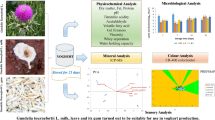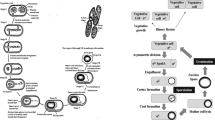Abstract
To evaluate the microbiological safety of Korean traditional seasoned beef processed by sous-vide method, Clostridium perfringens spores were inoculated into the samples, and then germination and growth of spores were observed under different temperatures for days. Also, changes in pH, water activity, and salt contents were analyzed. As the results, there was no difference in water activity and pH of the samples during the storage at any temperature. However, salt contents of the samples significantly increased as storage time increased, and the storage temperature affected the change of salt contents. C. perfringens did not grow at 4 and 10°C for 24 days however, the bacterial growth was observed at 20°C after 2 days of storage. Based on these simulation tests, the microbiological safety of sous-vide processed galbijjim can be guaranteed at 4 and 10°C for 24 days even though the raw materials were contaminated by C. perfringens spores.
Similar content being viewed by others
References
Nyati H. An evaluation of the effect of storage and processing temperatures on the microbiological status of sous vide extended shelf-life products. Food Control 11: 471–476 (2000)
Juneja VK. Delayed Clostridium perfringens growth from a spore inocula by sodium lactate in sous-vide chicken products. Food Microbiol. 23: 105–111 (2006)
Kim KM, Park JH, Shin WS. Optimized conditions of model processing for ready-to-eat style Galbi-jjim prepared by sous-vide and cook chill system. Korean J. Food Sci. Anim. Resour. 6: 673–679 (2009)
Shin WS, Kim KM, Park JH, Cho T. Evaluation of microbiological, physicochemical and sensory properties of galbi-jjim prepared by sous-vide and cook chill method at different temperatures. Korean J. Food Sci. Anim. Resour. 5: 722–729 (2010)
Pulgar JS, Gázquez A, Ruiz-Carrascal J. Physico-chemical, textural, and structural characteristics of sous-vide cooked pork cheeks as affected by vacuum, cooking temperature, and cooking time. Meat Sci. 90: 828–835 (2012)
Daelman J, Jacxsens L, Devlieghere F, Uyttendaele M. Microbial safety and quality of various types of cooked chilled foods. Food Control 30: 510–517 (2013)
Schellekens M. New research issues in sous-vide cooking. Trends Food Sci. Technol. 7: 256–262 (1996)
Creed PG, Reeve W. Principles and application of sous-vide processed foods. pp. 57–88. In: Sous-vide and Cook-Chill Processing for the Food Industry. Ghazala IS (ed). Aspen Publishers, Gaithersburg, MD, USA (1998)
Paik HD, Kim HJ, Nam KJ, Kim CJ, Lee SE, Lee DS. Effect of nisin on the storage of sous-vide processed Korean seasoned beef. Food Control 17: 994–1000 (2006)
Peck MW. Clostridium botulinum and the safety of minimally heated, chilled foods: An emerging issue? J. Appl. Microbiol. 101: 556–570 (2006)
Brynestad S, Granum PE. Clostridium perfringens and foodborne infections. Int. J. Food Microbiol. 74: 195–202 (2002)
Greig JD, Ravel A. Analysis of food-borne outbreak data reported internationally for source attribution. Int. J. Food Microbiol. 130: 77–87 (2009)
Byrne B, Dunne G, Bolton DJ. Thermal inactivation of Bacillus cereus and Clostridium perfringens vegetative cells and spores in pork luncheon roll. Food Microbiol. 23: 803–808 (2006)
Juneja VK, Call JE, Miller AJ. Evaluation of methylxanthines and related compounds to enhance Clostridium perfringens sporulation using a modified Duncan and Strong medium. J. Rapid Meth. Aut. Mic. 2: 203–218 (1993)
Velugoti PR, Rajagopal L, Juneja V, Thippareddi H. Use of calcium, potassium, and sodium lactates to control germination and outgrowth of Clostridium perfringens spores during chilling of injected pork. Food Microbiol. 24: 687–694 (2007)
Kang CK, Woodburn M, Pagenkopf A, Cheney R. Growth, sporulation, and germination of Clostridium perfringens in media of controlled water activity. Appl. Microbiol. 18: 798–805 (1969)
Cho SH, Kim JH, Seong PN, Cho YM, Chung BY, Chung MO, Kim DH, Lee JM, Ahn CN. Physico-chemical meat quality properties and nutritional composition of Hanwoo steer beef with 1++ quality grade. Korean J. Food Sci. Anim. Resour. 28: 422–430 (2008)
Jin SK, Kim IS, Hah KH, Hur SJ, Park KH, Lyou HJ, Bae DS. Changes of qualities in aerobic packed ripening pork using a Korean traditional seasoning during storage. J. Anim. Sci. Technol. 47: 73–82 (2005)
Juneja VK, Majka WM. Outgrowth of Clostridium perfringens spores in cook-in-bag beef products. J. Food Safety 15: 21–34 (1995)
Juneja VK, Marmer BS. Growth of Clostridium perfringens from spore inocula in sous-vide turkey products. Int. J. Food Microbiol. 32: 115–123 (1996)
Juneja VK, Thippareddi H. Inhibitory effects of organic acid salts on growth of Clostridium perfringens from spore inocula during chilling of marinated ground turkey breast. Int. J. Food Microbiol. 93: 155–163 (2004)
Author information
Authors and Affiliations
Corresponding author
Rights and permissions
About this article
Cite this article
Shin, WS., Moon, GS. & Park, JH. Growth of Clostridium perfringens spores inoculated in sous-vide processed Korean traditional Galbijjim under different storage conditions. Food Sci Biotechnol 23, 505–509 (2014). https://doi.org/10.1007/s10068-014-0069-5
Received:
Revised:
Accepted:
Published:
Issue Date:
DOI: https://doi.org/10.1007/s10068-014-0069-5




